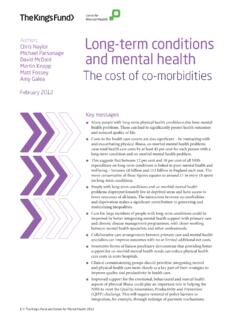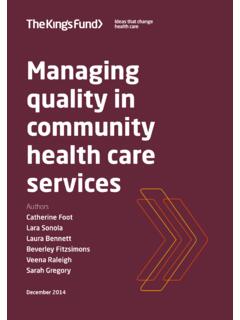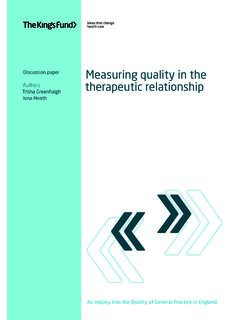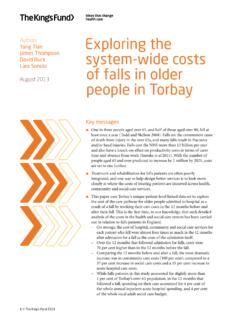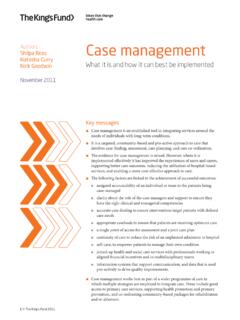Transcription of Supporting people to manage their health - King's Fund
1 Supporting people to manage their healthAn introduction to patient activationAuthorsJudith HibbardHelen GilburtMay 2014 Supporting people to manage their health561234 Contents 1 Contents1 Key messages 32 Introduction 53 An overview of patient activation 7 What is patient activation? 7 Measuring patient activation 8 The relationship between patient activation and outcomes 11 Can patient activation be increased? 15 Summary 184 How the measurement of patient activation is used 19 Intervening to improve patient engagement and outcomes 19 Using patient activation in population segmentation and risk stratification to target interventions 27 Measuring the performance of health care systems and evaluating the effectiveness of interventions to involve patients 29 Summary 31 Contents 2 Supporting people to manage their health5612345 Implementation of the patient activation measure 32 Using the PAM to reduce health inequalities 32
2 Using the PAM to support self-management 32 Using the PAM to deliver outcomes-based care 33 Considerations for implementing the PAM in clinical care 34 Considerations for implementation in risk stratification 36 Support for implementation 38 Summary 386 Conclusions and key recommendations 39 Key recommendations 40 References 42 About the authors 51 Acknowledgements 51 Key messages 3 Supporting people to manage their health5612341 Key messages Patient activation is a widely recognised concept. It describes the knowledge, skills and confidence a person has in managing their own health and health care. people who have low levels of activation are less likely to play an active role in staying healthy. They are less good at seeking help when they need it, at following a doctor s advice and at managing their health when they are no longer being treated.
3 their lack of confidence and their experience of failing to manage their health often means that they prefer not to think about it. The Patient Activation Measure (PAM) is a patient-reported measure that has been validated in the United Kingdom. It is a powerful and reliable measure of patient activation. Patient activation scores have been robustly demonstrated to predict a number of health behaviours . They are closely linked to clinical outcomes, the costs of health care and patients ratings of their experience. Highly activated patients are more likely to adopt healthy behaviour, to have better clinical outcomes and lower rates of hospitalisation, and to report higher levels of satisfaction with services. Patients with low activation levels are more likely to attend accident and emergency departments, to be hospitalised or to be re-admitted to hospital after being discharged. This is likely to lead to higher health care costs.
4 The relationship between patient activation and health outcomes has been demonstrated across a range of different populations and health conditions. Intervening to increase activation can improve a patient s engagement and health outcomes and is an important factor in helping patients to manage their health . Improvements in patient activation scores have been seen for up 18 months following intervention. Key messages 4 Supporting people to manage their health561234 Tailoring service delivery according to patient activation levels can maximise productivity and efficiency by ensuring that the level of support provided is appropriate to the needs of the individual. Patient activation is a powerful mechanism for tackling health inequalities. Used in population segmentation and risk stratification, it provides new insights into risk that go beyond those obtained using traditional socio-demographic factors. Patient activation provides a unique measure of engagement and empowerment that can be used to evaluate the effectiveness of interventions and to measure the performance of health care organisations in involving patients in their own care.
5 Introduction 5 Supporting people to manage their health5612342 Introduction The UK health care system is arguably facing some of the greatest challenges in its history. Population growth, breakthroughs in the treatment and management of health conditions and changes to levels of patient need have led to a system that is increasingly under pressure and financially unsustainable. In considering how best to develop an effective system that delivers quality care and value for money and one that is able to meet future demand the role that patients play has become ever more people do in their everyday lives what they eat, how much they exercise and how far they follow medical advice largely determines their health and their need for health care (World health Organization 2005).
6 The influence of patient behaviour on health outcomes can be seen in everything from preventing illness in the first place through to the management of long-term health conditions. As 60 to 70 per cent of premature deaths are caused by behaviours that could be changed (Schroeder 2007), it is essential that patients and the general public become more engaged with adopting positive health number of mechanisms to help individuals take a greater interest in their own health have been developed. These include public health initiatives aimed at changing behaviour and interventions such as shared decision-making and co-production to increase the number of health care decisions made jointly by patients and professionals. However, progress has been slow. A key consideration is how far people are able to participate in their own health care. While some individuals are very proactive about their health , many are quite passive. Until we can understand what it means to be an empowered patient and, crucially, how health services can help people become more empowered, it is likely that a substantial proportion of the population will fail to take a more active role.
7 This paper introduces a way of conceptualising and measuring engagement that is known as patient activation . Patient activation provides a better understanding of why some patients engage fully with their health and others do not. More importantly, the study of patient activation has led to the design of many effective Introduction 6 Supporting people to manage their health561234interventions, which in turn have led to greater patient participation and engagement in health care. Drawing on evidence from the United States and the United Kingdom, the paper demonstrates how using patient activation to intervene in the delivery of health and health care can reduce health inequalities, deliver improved outcomes, better quality care and lower costs.
8 An overview of patient activation 7 Supporting people to manage their health5612343 An overview of patient activationWhat is patient activation?Patient activation is a behavioural concept. It captures a number of core components of patient involvement, each of which is important for active engagement and participation. It is defined as an individual s knowledge, skill, and confidence for managing their health and health care (Hibbard et al 2005). Patients with high levels of activation understand their role in the care process and feel capable of fulfilling that role. Individuals with long-term conditions who are more highly activated are more likely to engage in positive health behaviours and to manage their health conditions more effectively. Between 25 and 40 per cent of the population have low levels of activation (Hibbard and Cunningham 2008). Individuals with low levels of activation are more likely to: feel overwhelmed with the task of managing their health have little confidence in their ability to have a positive impact on their health misunderstand their role in the care process have limited problem-solving skills have had substantial experience of failing to manage their health , and have become passive in managing their health say that they would rather not think about their course, these are all major barriers to an individual s ability to manage their own health .
9 If a patient feels overwhelmed, has little confidence and has experience of An overview of patient activation 8 Supporting people to manage their health561234failing to manage their health , imagine how they will respond when a doctor tells them that, because of a new diagnosis, they need to make multiple changes to their lifestyle changing their diet, increasing their physical activity and managing new medications. They may try to make these changes, but when they cannot make all of them, they will most likely make none. By not understanding that a patient like this has limited self-management skills, their doctor has set them up for failure. Measuring patient activationIn health care, it is commonly understood that measurement is a necessary first step in effectively improving care. The Patient Activation Measure (PAM) is the most commonly used measure of activation. Like patient-reported outcome measures (PROMs) and patient-reported experience measures (PREMs), the PAM is a measure that patients complete themselves, although they can be supported in this process.
10 The PAM contains a series of 13 statements designed to assess the extent of a patient s activation. These statements are about beliefs, confidence in the management of health -related tasks and self-assessed knowledge. Patients are asked to rate the degree to which they agree or disagree with each statement. These answers are combined to provide a single score of between 0 and 100, which represents the person s concept of themselves as an active manager of their health and health care. Although patient activation scores lie between 0 and 100, for the purpose of intervention they are often subdivided into four groups, known as levels of activation . These range from low activation to high activation. They are based on experience and observation; provide a means of understanding the patient s capabilities, beliefs and likely behaviours at different points along the scale; and are used to support patients more appropriately. However, the 0 100 score is the most useful for determining patient progress or assessing the impact of interventions.
